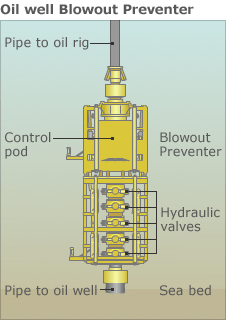A Deepwater Horizon rig worker has told the BBC that he identified a leak in the oil rig’s safety equipment weeks before the explosion.
Tyrone Benton said the leak was not fixed at the time, but that instead the faulty device was shut down and a second one relied on.
BP said rig owners Transocean were responsible for the operation and maintenance of that piece of equipment.
Transocean said it tested the device successfully before the accident.
Meanwhile, BP has said that its costs in tackling the disaster have now risen to $2bn (£1.34bn).
‘
‘Unacceptable
On 20 April, when the Deepwater Horizon rig exploded killing 11 people, the blowout preventer, as the device is known, failed.
The most critical piece of safety equipment on the rig, they are designed to avert disasters just like the oil spill in the Gulf of Mexico.
The blowout preventer (BOP) has giant shears which are designed to cut and seal off the well’s main pipe. The control pods are effectively the brains of the blowout preventer and contain both electronics and hydraulics. This is where Mr Benton said the problem was found.
“We saw a leak on the pod, so by seeing the leak we informed the company men,” Mr Benton said of the earlier problem he had identified. “They have a control room where they could turn off that pod and turn on the other one, so that they don’t have to stop production.”
Professor Tad Patzek, petroleum expert at the University of Texas, was blunt in his assessment: “That is unacceptable. If you see any evidence of the blowout preventer not functioning properly, you should fix it by whatever means possible.”
Mr Benton said his supervisor e-mailed both BP and Transocean about the leaks when they were discovered.
Daily costs
He said he did not know whether the leaking pod was turned back on before the disaster or not.
He said to repair the control pod would have meant temporarily stopping drilling work on the rig at at time when it was costing BP $500,000 (£337,000) a day to operate the Deepwater Horizon.
Henry Waxman, a House of Representatives Democrat who is overseeing congressional investigations into the rig disaster, has accused BP of taking safety shortcuts to save money.
“BP appears to have made multiple decisions for economic reasons that increased the danger of a catastrophic well failure,” Mr Waxman said.
BP chief executive Tony Hayward, giving evidence to Congress, said: “There is nothing I have seen in the evidence so far that suggests that anyone put cost ahead of safety, if there are then we will take action.”
Congress has identified numerous other problems with the blowout preventer, including design problems, unexpected modifications and a flat battery.
Cement job
The other major problems on the rig, Congress has said, centred around the cement job. Cement in an oil well blocks explosive gases from escaping, and it appears the cement may not have set properly on the Deepwater Horizon.
BP said it had indications of a successful cementing operation and the company that was in charge of the cement job, Halliburton, has said it was consistent with that used in similar applications.
Several rig workers the BBC spoke to who were on the Deepwater Horizon said there was pressure in April to work fast.
Work to prepare and then seal the well was behind schedule and had to be completed before a production rig could move in and start turning profits.
“Too many jobs were being done at one time. It should have just really slowed down and just took one job at a time, to make sure everything was done the way it should have been,” said Mr Benton, who is now suing BP and Transocean for negligence.
BP has responded to Mr Benton’s account saying Transocean was responsible for both the maintenance and operation of the blowout preventer.

BBC
